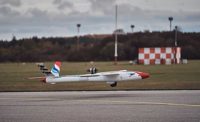During the first five decades of commercial aviation, aircraft design changed dramatically. However, that hasn’t been the case over the last 50 years. Despite major developments in materials, the basic shape of commercial aircraft has remained relatively the same since the 1960s.
Whether it’s a business jet, a regional turboprop or a long-haul jetliner, most airplanes feature the same design elements. Typically, there’s a tubular fuselage attached to a pair of swept-back wings and a T-shaped tail section. Engines are mounted either under the wings or aft-mounted onto the fuselage with pods.
Those age-old design elements could someday go the way of fabric-covered wings, open cockpits and radial engines. That’s because aerospace engineers are using new technology, such as additive manufacturing and generative design software, to push beyond traditional boundaries and create cutting-edge aircraft that operate quieter, burn less fuel and reduce emissions.
Emerging technology, such as electric propulsion systems, is also enabling entrepreneurs to create entirely new classes of aircraft that will serve new roles in the future.
“For the past 50 years, most of our experience with aircraft has involved traveling between large airports with hundreds of fellow passengers,” says Juan Alonso, a professor of aeronautics and astronautics and head of the Aerospace Design Laboratory at Stanford University. “Recent technological revolutions, however, will make future aircraft more important to our lives in many ways.
“From silent, efficient global transportation to personal or on-demand flight that frees us from roads, to autonomous air vehicles for delivery of information and goods, the future of flight will look considerably different than it does today,” claims Alonso.
“We are at a tipping point in commercial aviation,” adds Jim Heidmann, manager of NASA’s Advanced Air Transport Technology Project. “We are exploring and developing game-changing technologies and concepts that can dramatically improve efficiency, reduce environmental impact and accelerate the introduction of new aircraft.”
“But, any design changes won’t happen overnight,” warns Richard Aboulafia, vice president of analysis at the Teal Group Corp., an aerospace and defense market research firm. “Aerospace is a cutting-edge industry with very long lead times.”
New Forms of Propulsion
Commercial aircraft manufacturers have already adopted numerous technologies that help make today’s generation of jetliners more energy-efficient than ever.
“Because of the amazing progress in jet engine efficiency, every year they get 1 percent to 2 percent better at fuel burn,” says Aboulafia. “Innovative fuselage shapes aren’t going to be adopted just because they’re cool or cutting edge. New propulsion concepts will drive future acceptance by conservative airframers.”
However, Aboulafia says there’s growing interest in exploring alternative propulsion systems, such as ultra-high bypass turbofan engines.
“They have the potential for significant reductions in fuel burn, noise and emissions,” explains Aboulafia. “But, to work effectively, these engines will need plenty of clearance and width. That would require new fuselage and wing designs to minimize the impact on aircraft performance.
“Because ultra-high bypass engines need big fans to drive air, it would not be possible to mount them directly under wings,” Aboulafia points out. “That could lead to a need for radical airframe changes, such as trapezoidal wings.”
Engineers at Boeing have already been working on a design called the transonic truss-braced wing. They claim it will enable future jetliners to fly higher and faster than the previous concepts.
The new wing configuration gives jetliners unprecedented aerodynamic efficiency while flying at Mach 0.8. From end-to-end, the folding wings measure 170 feet. The high wingspan is made possible by the presence of a truss, which supports the extended length of an ultra-thin 20-degree swept wing.
Another new form of propulsion that is being evaluated by aerospace engineers is called boundary layer ingestion (BLI). With BLI, engines must be located near the rear of an aircraft so that air flowing over the fuselage becomes part of the mix of air going into the engine and is then accelerated out the back.
The goal is to reduce the total drag an airplane experiences in the sky. With less total drag, the engines need less thrust to push the airplane forward, which means they don’t have to burn as much fuel, which reduces emissions and saves on fuel expense.
“It all starts with the fact that as an airplane flies through the air, a layer of slower moving air begins to build up along the skin of the fuselage and wings, which is fittingly called the boundary layer,” says NASA’s Heidmann. “This slower moving air causes additional drag.
“At the front of the airplane, the thickness of the boundary layer is zero, but as the air flows back over the surface of the airplane’s fuselage and wings, the layer grows thicker,” explains Heidmann. “By the time it gets to the rear of the airplane, it can be a foot or more deep.”
In a conventional tube and wing airplane, where the jet engines are hung beneath the wings, that’s the end of the boundary layer story. The slower, drag-inducing airflow just continues off the rear of the airplane to mix with the undisturbed air there.
In that traditional jetliner configuration, the engine inlets are exposed to a nice, clean, uniform stream of air entering the engine, where the airflow is slowed down a bit to encounter the first set of fan blades.
“This is ideal for engine designers because, as the fan blades turn, they experience the same environmental conditions—the same air pressure and speed—with each revolution,” says Heidmann. “But, with the rear-mounted engines in the path of the boundary layer, the engine’s fan blades are exposed to additional stresses every time they pass through the distorted airflow.
“Things change dramatically when the airplane’s engines are put in the path of the boundary layer by positioning them at the extreme rear of the airplane,” claims Heidmann. “Engines are not mounted on either side of the tail on short pylons, as seen on some airliners or business jets today, but directly atop or behind the main fuselage.
“With the engines in this location, the slower, boundary layer air enters the engine and is then accelerated with the rest of the air passing through the engine and exhausted out the back,” Heidmann points out.
To explore the potential of BLI technology, NASA engineers conducted wind tunnel tests of a new airframe design dubbed the “double bubble.” It features a very wide, flat fuselage to provide extra lift, low-swept wings to reduce drag and weight, and engines sitting above the fuselage and aft of the wings to block some noise from reaching the ground.
Electric propulsion is also slowly emerging as a clean, quiet source of power for next-generation aircraft. An Israeli startup called Eviation Aircraft Ltd. is in the process of developing a nine-passenger all-electric commuter plane to compete against traditional turboprops.
The Alice features a carbon-fiber fuselage and a V-shaped tail equipped with a pusher propeller. A pair of pusher propellers at the wing-tips help reduce drag and increase redundancy.
Siemens engineers are developing the plane’s electric propulsion system, which is powered by a 980-kilowatt-hour lithium-ion battery. More than 9,000 battery cells are distributed throughout the aircraft, including the ceiling, floor and wings.
When it debuts at the Paris Air Show in June, the Alice aircraft is expected to have a range of up to 650 nautical miles, which is approximately 15 percent further than a similar-sized Cessna Caravan.
New Designs Take Shape
Several innovative designs being developed today may eventually be incorporated into the commercial airplanes of tomorrow. For instance, engineers in Italy are developing a plane that features an unconventional wing configuration; the front portion is connected to the lower part of the fuselage and the rear wing is joined to a vertical twin-tail.
The PrandtlPlane is designed to transport up to 50 percent more passengers than an Airbus A320 or a Boeing 737, the workhorses of modern aviation. Unlike truss-braced wings and other designs under development, the Italian plane’s configuration presents the least induced resistance of all the load-bearing structures with the same weight and wingspan.
Another futuristic design that intrigues aerospace engineers is the blended-wing-body (BWB), which is radically different than today’s tube-and-wing airplanes. Blending the wing, body and tail into a single wing can generate a 30 percent reduction in fuel consumption.
One intriguing concept is the Ascent 1000 from DZYNE Technologies, which has no flaps on its wings. It also has no tail, because that function has been blended into the wing.
“This results in a smooth, simple airframe built from relatively flat, manufacturable components,” says Mark Page, vice president of DZYNE. “The new design uses the same engines, electronics and cockpit systems as other airliners, so there are no special requirements for the BWB. It looks futuristic and different, but it is mechanically simpler than today’s airliners.”
Urban air mobility (UAM) is one of the hottest segments of the aerospace industry. It refers to small, easy-to-maneuver, on-demand passenger or cargo-carrying aircraft that function in crowded cities like flying taxi cabs. The goal is relieve gridlock on congested streets and highways.
The sector has attracted the attention of both startups and traditional powerhouses such as Airbus, Bell Helicopter and Boeing. Silicon Valley tech giants ranging from Alphabet to Uber are also vying for a share of the market.
“With 140 competitors, UAMs are by far the fastest growing segment of the aerospace industry,” says Pat Anderson, professor of aerospace engineering and director of the Eagle Flight Research Center at Embry-Riddle Aeronautical University. “UAMs are generating many innovative designs and configurations, including both winged and wingless aircraft that enable vertical takeoff and landing.”
Most designs currently being developed use carbon-fiber composite fuselages to reduce weight, multiple propulsion systems such as fan ducts or rotor blades, and either all-electric or hybrid-electric propulsion systems to reduce noise.
Future scenarios envision urban skies filled with thousands of UAMs landing and taking off simultaneously. But, for this new breed of aircraft to be economically viable, production volumes will need to range from 5,000 to 10,000 units a year, which is a big jump from today’s typical aircraft volumes that typically average around 100 to 500 units.
To learn more about aerospace design trends, check out these articles:








